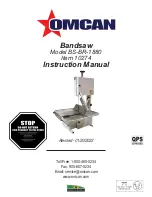
© by WilTec Wildanger Technik GmbH
Item 61950
Page 11
05 2021
-1
Danger!
Noises and vibrations
Sound and vibration values have been measured in accordance with EN 61029.
Sound pressure level L
pA
(
㏈
(A)) 91
Uncertainty K
pA
(
㏈
)
3
Sound power level L
WA
(
㏈
(A))
104
Uncertainty K
WA
(
㏈
)
3
The quoted values are emission values and not necessarily reliable workplace values. Although there
is a correlation between emission and immission levels, it is impossible to draw any certain conclusions
as to the need for additional precautions. Factors with a potential influence on the actual immission level
at the workplace include the duration of impact, the type of room, and other sources of noise etc., e. g.,
the number of machines and other neighbouring operations. Reliable workplace values may also vary
from country to country. With this information the user should at least be able to make a better assess-
ment of the dangers and risks involved.
Wear earmuffs.
The impact of noise can cause damage to hearing.
Keep the noise emissions and vibrations Keep the noise emissions and vibrations to a minimum.
•
Only use appliances which are in perfect working order.
•
Service and clean the appliance regularly.
•
Adapt your working style to suit the appliance.
•
Do not overload the appliance.
•
Have the appliance serviced whenever necessary.
•
Switch the appliance off when it is not in use.
Caution!
Residual risks
Even if you use this electric power tool in accordance with instructions, certain residual risks cannot be
rules out. The following hazards may arise in connection with the construction and layout of the device:
•
damage to lungs if no suitable protective dust mask is used;
•
damage to hearing if no suitable ear protection is used.
Before starting the device
Before you connect the device to the mains supply make sure that the data on the rating plate are
identical to the mains data.
Warning!
The maximum permissible system impedance is 0.340
Ω at the interface point of the user’s
supply.
Warning!
Always pull the power plug before making adjustments to the device.
•
Unpack the bench-type circular saw and check it for damage which may have occurred in transit.
•
The machine has to be set up where it can stand firmly, e. g., on a work bench, or it must be
bolted to a strong base.
•
All covers and safety devices have to be properly fitted before the machine is switched on.
•
It must be possible for the saw blade to run freely.
•
When working with wood that has been processed before, watch out for foreign bodies such as
nails or screws etc.
•
Before you actuate the on/off switch, make sure that the saw blade is correctly fitted and that
the moving parts of the device run smoothly.





































